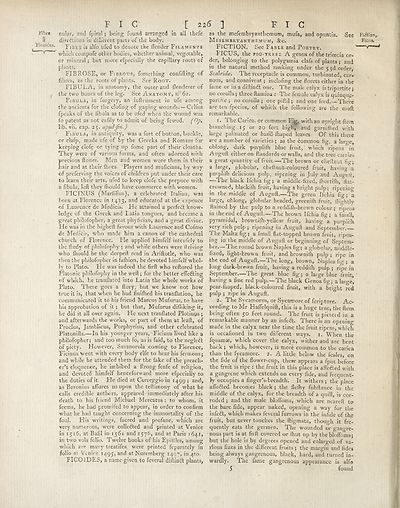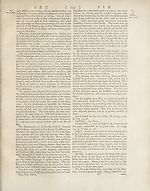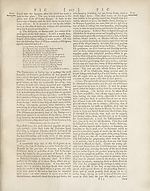Encyclopaedia Britannica > Volume 7, ETM-GOA
(248) Page 226
Download files
Complete book:
Individual page:
Thumbnail gallery: Grid view | List view

F I C [ 226 ] FIG
Fibre nular, and fpiral; being found arranged in ail thefe
il direftions in different parts of the body.
Ficoides. Fibss is alfo ufed to denote the flender Filaments
v which compofe other bodies, whether animal, vegetable,
or mineral; but more efpecially the capillary roots of
plants.
FIBROSE, or FiBROUs, fomething confifting of
fibres, as the roots of plants. See Root.
FIBULA, in anatomy, the outer and flendever of
the two bones of the leg. See Anatomy, ri062.
Fibula, in furgery, an inftrument in ufe among
the ancients for the doling of gaping wounds. — Ctifus
fpeaks of the fibula as to be ufed when the wound was
fo patent as not eafily to admit of being fewed. (Op.
lib. vii. cap. 25. apudjin.)
Fibula, in antiquity, was a fort ofbutton, buckle,
or clafp, made ufe of by the Greeks and Romans fqr
keeping clofe or tying up fome part of their cloaths.
They were of various forms, and often adorned with
precious {tones. Men and women wore them in their
hair and at their (hoes. Players and muficians, by way
of preferving the voices of children put under their care
to learn their arts, ufed to keep clofe the prepuce with
a fibula, left they fhould have commerce with women.
FICINUS (Marfilius), a celebrated Italian, was
born at Florence in 1433, and educated at the expen.ce
of Laurence de Medicis. He attained a perfect know¬
ledge of the Greek and Latin tongues, and became a
great philofopher, a great phyfician, and a great divine.
He was in the higheft favour with Laurence and Cofmo
de Medicis, who made him a canon of the cathedral
church of Florence. He applied himfelf intenfely to
the tludy of philofophy ; and while others were driving
who fhould be the deepeft read in Ariftotle, who was
then the philofopher in fafhion, he devoted himfelf whol¬
ly to Plato. He was indeed the firft who reftored the
Platonic philofophy in the weft; for the better effefting
cf which, he tranflated into Latin the whole works of
Plato. There goes a ftory; but we know not how
true it is, that when he had finifhed his tranflation, he
communicated it to his friend Marcus Mufurus, to have
his appi'obation of it; but that, Mufurus difliking it,
he did it all over again. He next tranflated Plotinus;
and afterwards the works, or part of them at leaft, of
Proclus, Jamblicus, Porphyrins, and other celebrated
Platonifts.—In his younger years,'Ficinus lived like a
philofopher; and too much fo, as is faid, to the negleft
of piety. However, Savanorola coming to Florence,
Ficinus Went with every body elfe to hear his fermons;
and while he attended them for the fake of the preach¬
er’s eloquence, he inr,bibed a ftrong fenfe of religion,
and devoted himfelf henceforward more efpecially to
the duties of it. He died at Correggio in 1499 » an^>
as Baronius affures us upon the teftimony of what he
calls credible authors, appeared immediately after his
death to his friend Michael Mercatus: to whom, it
feems, he had promifed to appear, in order to confirm
what he had taught concerning the immortality of the
foul. His writings, facred and profane, which are
very numerous, were colle&ed and printed at Venice
in 1516, at Bafil in 1561 and 157(1, and at Paris 1641,
in two vols folio. Twelve books of his Epiftles, among
which are many treatifes. were printed feparately in
folio at Venice 1495, and at Nuremberg 1497, in 410.
FICOIDES, a name given to feveral diftinft plants,
as the mefembryanthemum, mufa, and opuntia. See FiAIory
MESEMBRYANTHEMUM, &C. Ficus.
FICTION. See Fable and Poetry. 1
FICUS, the fig-tree: A genus of the tricecia or¬
der, belonging to the polygamia clafs of plants; and
in the natural method ranking under the 5 3d order,
ScabrldtB. The receptacle is common, turbinated, car-
nous, and connivent; inclofing the florets either in the
fame or in a diftinft one. The male calyx is tripartite;
no corolla; three ftamina : The female calyx is quinqug-
partrte ; no corolla ; one piftil; and one feed.—There
are ten fpecies, of which the following are the moft
remarkable.
1. The Carica, or common Fig, with an upright Item
branching. 15 or 20 feet high; and garnifhed with
large palmated or hand-fhaped leaves. Of this there
are a number of varieties; as the common fig, a large,
oblong, dark purplifh blue fruit, which ripens in
Auguft either on ftandards or walls, and the tree carries
a great quantity of fruit.—The brown or cheftnut fig;
a large, globular, cheftnut-coloured fruit, having^a
purplifh delicious pulp, ripening in July and Auguft,
—The black Ifchia fig; a middle-fized, fhortifh, flat-
crowned, blackifh fruit, having a bright pulp; ripening
in the middle of Auguft.—The green Kchia fig; a
large, oblong, globular headed, greenifh fruit, flightly
ftained by the pulp to a reddifh-brown colour; ripens
in the end cf Auguft.—The brown Ifchia fig; a fmall,
pyramidal, brownifh-yellow fruit, having a purplifh
very rich pulp ; ripening in Auguft and September.—
The Malta fig; a fmall flat-topped brown fruit, ripen¬
ing in the middle of Auguft or beginning of Septem¬
ber.—The round brown Naples fig; a globular, middle-
fized, light-brown fruit, and brownifh pulp ; ripe in
the end of Auguft.—The long, brown, Naples fig ; a
long dark-br«wn fruit, having a reddifh pulp ; ripe in
September.—The great blue fig; a large blue fruit,
having a fine red pulp.—The black Genoa fig; a large,
pear-fhaped, black-coloured fruit, with a bright red
pulp ; ripe in Auguft.
2. The Sycamorus, or Sycamore of fcripture. Ac¬
cording to Mr Haflelquift, this is a huge true, the ftem
being often 50 feet round. The fruit is pierced in a
remarkable manner by an infeft. There is an opening
made in the calyx near the time the fruit ripens, which
is occafioned in two different - ways. 1. When the
fquamae, which cover the ealyx, wither and are bent
back; which, however, is more compion to the carica
than the fycamore. 2. A little below the fcales, on
the fide of the flower-cup, thene appears a fpot before
the fruit is ripe : the fruit in this place is affe&ed with
a gangrene which extends on every fide, and frequent¬
ly occupies a finger’s-breadth. It withers; the place
affedled becomes black ; the flefhy fubftance in the
middle of the calyx, for the breadth of a quill, is cor¬
roded ; and the male bloffoms, which are neareft to
the bare fide, appear naked, opening a way for the
infeft, which makes feveral furrows in the infide of the
fruit, but never touches the ftigmata, though it fre¬
quently eats the germen. The wounded or gangre¬
nous part is at firft covered or fhut up by the bloffoms;
but the hole is by degrees opened and enlarged of va¬
rious fizes in the different fruits; the margin and Tides
being always gangrenous, black, hard, and turned in¬
wardly. The fame gangrenous appearance is alfo
5 found
Fibre nular, and fpiral; being found arranged in ail thefe
il direftions in different parts of the body.
Ficoides. Fibss is alfo ufed to denote the flender Filaments
v which compofe other bodies, whether animal, vegetable,
or mineral; but more efpecially the capillary roots of
plants.
FIBROSE, or FiBROUs, fomething confifting of
fibres, as the roots of plants. See Root.
FIBULA, in anatomy, the outer and flendever of
the two bones of the leg. See Anatomy, ri062.
Fibula, in furgery, an inftrument in ufe among
the ancients for the doling of gaping wounds. — Ctifus
fpeaks of the fibula as to be ufed when the wound was
fo patent as not eafily to admit of being fewed. (Op.
lib. vii. cap. 25. apudjin.)
Fibula, in antiquity, was a fort ofbutton, buckle,
or clafp, made ufe of by the Greeks and Romans fqr
keeping clofe or tying up fome part of their cloaths.
They were of various forms, and often adorned with
precious {tones. Men and women wore them in their
hair and at their (hoes. Players and muficians, by way
of preferving the voices of children put under their care
to learn their arts, ufed to keep clofe the prepuce with
a fibula, left they fhould have commerce with women.
FICINUS (Marfilius), a celebrated Italian, was
born at Florence in 1433, and educated at the expen.ce
of Laurence de Medicis. He attained a perfect know¬
ledge of the Greek and Latin tongues, and became a
great philofopher, a great phyfician, and a great divine.
He was in the higheft favour with Laurence and Cofmo
de Medicis, who made him a canon of the cathedral
church of Florence. He applied himfelf intenfely to
the tludy of philofophy ; and while others were driving
who fhould be the deepeft read in Ariftotle, who was
then the philofopher in fafhion, he devoted himfelf whol¬
ly to Plato. He was indeed the firft who reftored the
Platonic philofophy in the weft; for the better effefting
cf which, he tranflated into Latin the whole works of
Plato. There goes a ftory; but we know not how
true it is, that when he had finifhed his tranflation, he
communicated it to his friend Marcus Mufurus, to have
his appi'obation of it; but that, Mufurus difliking it,
he did it all over again. He next tranflated Plotinus;
and afterwards the works, or part of them at leaft, of
Proclus, Jamblicus, Porphyrins, and other celebrated
Platonifts.—In his younger years,'Ficinus lived like a
philofopher; and too much fo, as is faid, to the negleft
of piety. However, Savanorola coming to Florence,
Ficinus Went with every body elfe to hear his fermons;
and while he attended them for the fake of the preach¬
er’s eloquence, he inr,bibed a ftrong fenfe of religion,
and devoted himfelf henceforward more efpecially to
the duties of it. He died at Correggio in 1499 » an^>
as Baronius affures us upon the teftimony of what he
calls credible authors, appeared immediately after his
death to his friend Michael Mercatus: to whom, it
feems, he had promifed to appear, in order to confirm
what he had taught concerning the immortality of the
foul. His writings, facred and profane, which are
very numerous, were colle&ed and printed at Venice
in 1516, at Bafil in 1561 and 157(1, and at Paris 1641,
in two vols folio. Twelve books of his Epiftles, among
which are many treatifes. were printed feparately in
folio at Venice 1495, and at Nuremberg 1497, in 410.
FICOIDES, a name given to feveral diftinft plants,
as the mefembryanthemum, mufa, and opuntia. See FiAIory
MESEMBRYANTHEMUM, &C. Ficus.
FICTION. See Fable and Poetry. 1
FICUS, the fig-tree: A genus of the tricecia or¬
der, belonging to the polygamia clafs of plants; and
in the natural method ranking under the 5 3d order,
ScabrldtB. The receptacle is common, turbinated, car-
nous, and connivent; inclofing the florets either in the
fame or in a diftinft one. The male calyx is tripartite;
no corolla; three ftamina : The female calyx is quinqug-
partrte ; no corolla ; one piftil; and one feed.—There
are ten fpecies, of which the following are the moft
remarkable.
1. The Carica, or common Fig, with an upright Item
branching. 15 or 20 feet high; and garnifhed with
large palmated or hand-fhaped leaves. Of this there
are a number of varieties; as the common fig, a large,
oblong, dark purplifh blue fruit, which ripens in
Auguft either on ftandards or walls, and the tree carries
a great quantity of fruit.—The brown or cheftnut fig;
a large, globular, cheftnut-coloured fruit, having^a
purplifh delicious pulp, ripening in July and Auguft,
—The black Ifchia fig; a middle-fized, fhortifh, flat-
crowned, blackifh fruit, having a bright pulp; ripening
in the middle of Auguft.—The green Kchia fig; a
large, oblong, globular headed, greenifh fruit, flightly
ftained by the pulp to a reddifh-brown colour; ripens
in the end cf Auguft.—The brown Ifchia fig; a fmall,
pyramidal, brownifh-yellow fruit, having a purplifh
very rich pulp ; ripening in Auguft and September.—
The Malta fig; a fmall flat-topped brown fruit, ripen¬
ing in the middle of Auguft or beginning of Septem¬
ber.—The round brown Naples fig; a globular, middle-
fized, light-brown fruit, and brownifh pulp ; ripe in
the end of Auguft.—The long, brown, Naples fig ; a
long dark-br«wn fruit, having a reddifh pulp ; ripe in
September.—The great blue fig; a large blue fruit,
having a fine red pulp.—The black Genoa fig; a large,
pear-fhaped, black-coloured fruit, with a bright red
pulp ; ripe in Auguft.
2. The Sycamorus, or Sycamore of fcripture. Ac¬
cording to Mr Haflelquift, this is a huge true, the ftem
being often 50 feet round. The fruit is pierced in a
remarkable manner by an infeft. There is an opening
made in the calyx near the time the fruit ripens, which
is occafioned in two different - ways. 1. When the
fquamae, which cover the ealyx, wither and are bent
back; which, however, is more compion to the carica
than the fycamore. 2. A little below the fcales, on
the fide of the flower-cup, thene appears a fpot before
the fruit is ripe : the fruit in this place is affe&ed with
a gangrene which extends on every fide, and frequent¬
ly occupies a finger’s-breadth. It withers; the place
affedled becomes black ; the flefhy fubftance in the
middle of the calyx, for the breadth of a quill, is cor¬
roded ; and the male bloffoms, which are neareft to
the bare fide, appear naked, opening a way for the
infeft, which makes feveral furrows in the infide of the
fruit, but never touches the ftigmata, though it fre¬
quently eats the germen. The wounded or gangre¬
nous part is at firft covered or fhut up by the bloffoms;
but the hole is by degrees opened and enlarged of va¬
rious fizes in the different fruits; the margin and Tides
being always gangrenous, black, hard, and turned in¬
wardly. The fame gangrenous appearance is alfo
5 found
Set display mode to:
![]() Universal Viewer |
Universal Viewer | ![]() Mirador |
Large image | Transcription
Mirador |
Large image | Transcription
Images and transcriptions on this page, including medium image downloads, may be used under the Creative Commons Attribution 4.0 International Licence unless otherwise stated. ![]()
| Encyclopaedia Britannica > Encyclopaedia Britannica > Volume 7, ETM-GOA > (248) Page 226 |
|---|
| Permanent URL | https://digital.nls.uk/189124453 |
|---|
| Attribution and copyright: |
|
|---|
| Description | Ten editions of 'Encyclopaedia Britannica', issued from 1768-1903, in 231 volumes. Originally issued in 100 weekly parts (3 volumes) between 1768 and 1771 by publishers: Colin Macfarquhar and Andrew Bell (Edinburgh); editor: William Smellie: engraver: Andrew Bell. Expanded editions in the 19th century featured more volumes and contributions from leading experts in their fields. Managed and published in Edinburgh up to the 9th edition (25 volumes, from 1875-1889); the 10th edition (1902-1903) re-issued the 9th edition, with 11 supplementary volumes. |
|---|---|
| Additional NLS resources: |
|

